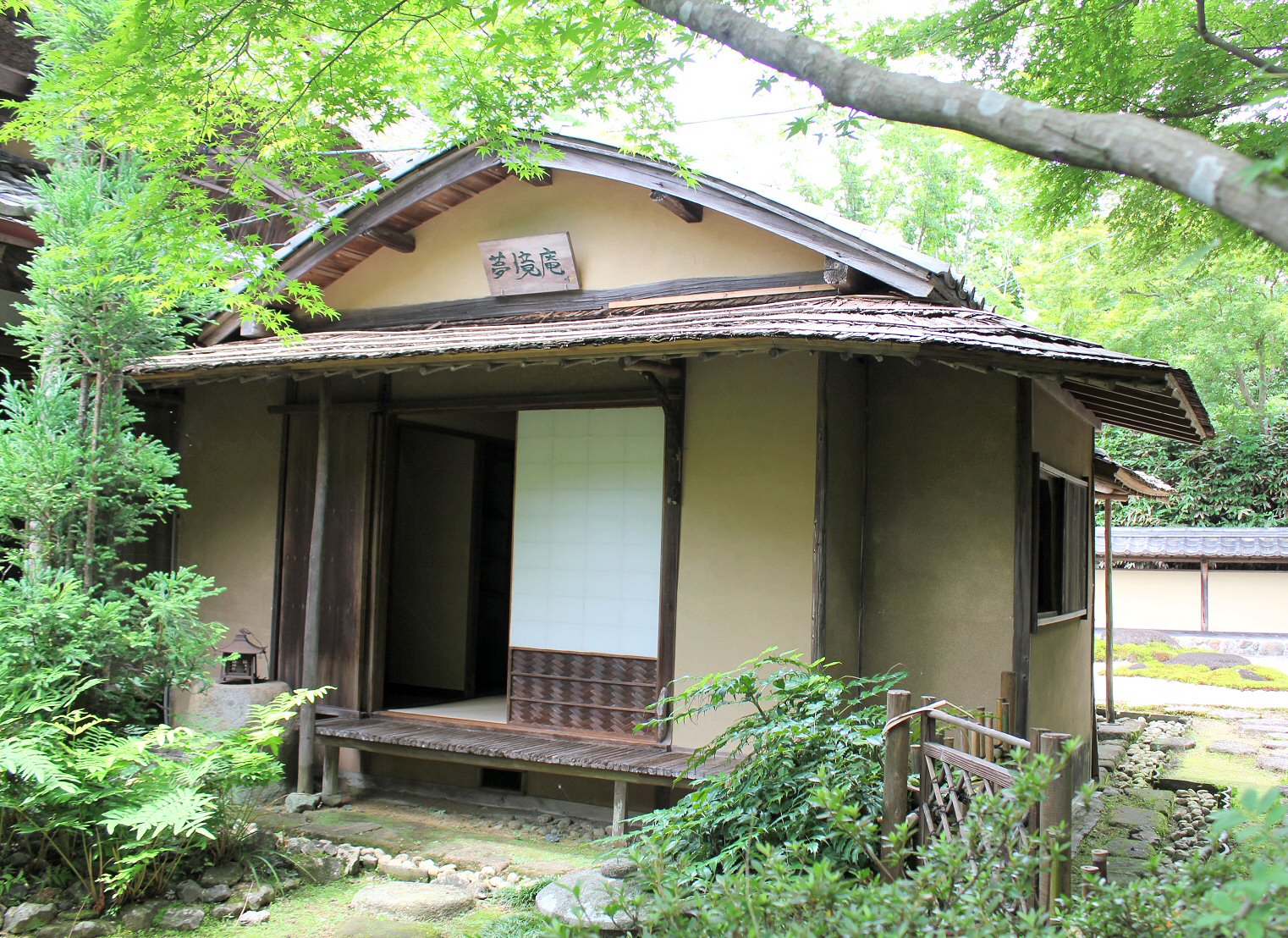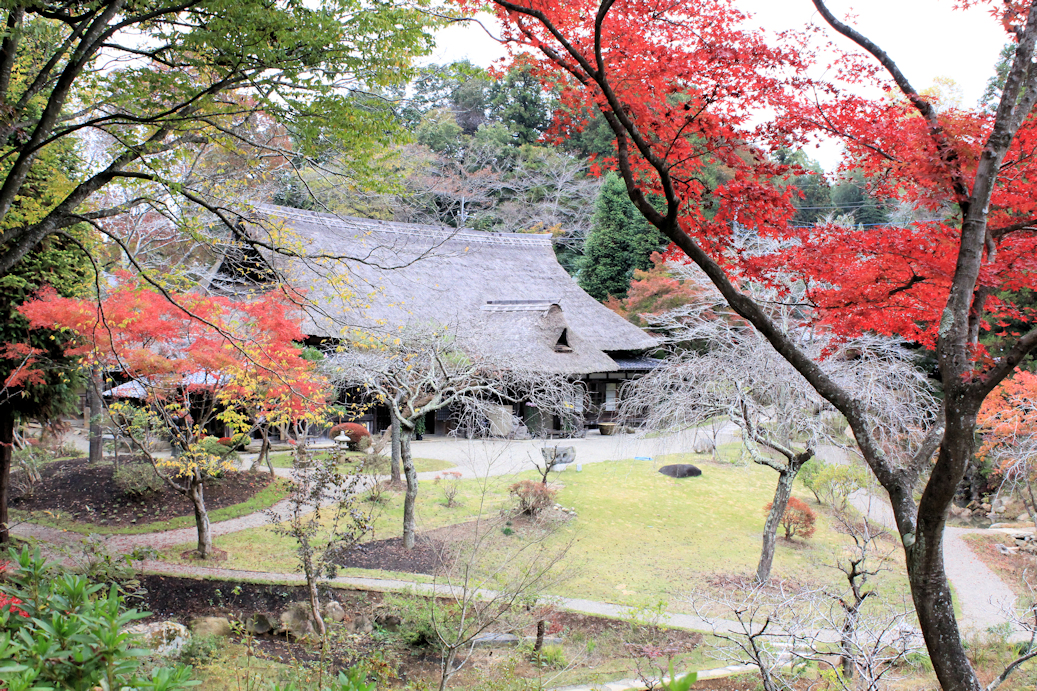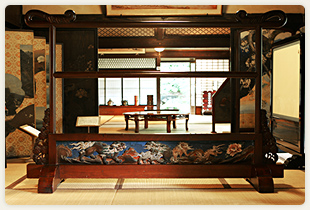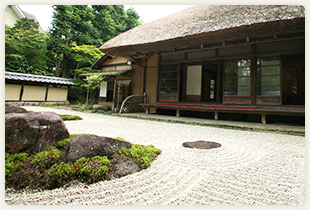The Shunpu banri so 春風萬里荘
最新情報 / Latest News
沿革と景観 / History and Scenery

笠間市「芸術の村」に佇む春風萬里荘・・・北大路魯山人が好んで用いた造語が「春風萬里」でした。
笠間市は、古くから稲荷と焼き物の町として広く知られてきましたが、その恵まれた自然環境は最近特に注目を集めています。豊かな緑と盆地特有の四季折々の自然界の変化の妙は、訪れる人の心を惹きつけて和ませてくれます。「芸術の村」は市街地を包むようにして広がるそうした緑濃い丘陵地にあります。
昭和39(1964)年、洋画家朝井閑右衛門と小説家田村泰次郎が、長谷川仁笠間日動美術館前理事長と笠間を訪れた折り、笠間にアトリエを作りたいという作家達の要望から、「芸術の村」の構想がでてきました。
Kasama City, widely known as a city of Inari (the fox deity) and pottery, drew people's new attentions especially for its abundant natural environment. Rich green and the seasonal changes of nature, special to the basin, catch and soothe the people's heart. The Village of Art located on the verdurous hilly land spreading around the city.
The initial plan of the Village of Art took shape after the wish of artists as Kanemon ASAI and a novelist Taijiro TAMURA who visited Kasama in 1964, with Mr. Jin HASEGAWA, the first director of the Kasama Nichido Museum of Art.

昭和40年には、北大路魯山人が住居としていた約300平方メートルの茅葺き民家を北鎌倉より移築し、「春風萬里荘」と名付け、「芸術の村」は開設されました。「春風萬里」とは、北大路魯山人が好んで用いた造語です。
芸術の村には、洋画家、日本画家、彫刻家、陶芸家、染織家などのアトリエが点在し、それぞれ制作に打ち込んでいます。
In 1965, the traditional Japanese house with a thatched roof of around 300 square meters, a former residence of KITAOJI Rosanjin, relocated to the Village of Art, and it was named "Shunpuu Banri-sou," after the Rosanjin's favorite verses by Li Haku.
There are currently 40 ateliers of the artists, devoting themselves to the works of Western-style painting, Japanese-style painting, sculpture, pottery, dying and weaving textile.

春風萬里荘の前には広大な庭園があり、桜、梅、つつじ、もみじ、花菖蒲などをはじめとする多くの草木が生い茂り、それぞれの趣の花々が一年中咲き誇り、訪れる者の心をひとしお和ませます。 また、江戸時代の豪農屋敷の長屋門、北大路魯山人自らが設計した茶室「夢境庵」、京都・龍安寺を模してつくられた枯山水による石庭、睡蓮の池にかかる太鼓橋などもととのえられており、美術鑑賞に疲れた来館者に憩いをもたらしています。
The vast garden in front of the Shunpu Banri-sou has the various trees and plants, as cherry trees, apricot trees, azaleas, maple trees and Japanese irises. The flowers of different tastes bloom all through the year, and sooth the visitors' hearts so much.
Besides, there are some other features offering a break to the visitors after appreciation of art; such as the nagaya gate for samurai residence in the Edo period, the tea room "Mukyo-an" designed by KITAOJI Rosanjin himself, the garden with stones without water modeled on the dry landscape of a temple Ryoan-ji in Kyoto, and an arched bridge over the pond of water lilies.
北大路魯山人・収蔵品 / KITAOJI Rosanjin & Collection

江戸時代中期の茅葺き民家を今に伝える・・・昭和の初めに北大路魯山人が北鎌倉に移築し住居に。そして笠間へ。
笠間日動美術館の分館である春風萬里荘は、昭和40(1965)年に北鎌倉より移築されました。 この茅葺き入母屋造りの重厚な構えの江戸時代中期の民家は、もともとは、現在の神奈川県厚木市近郊の地にあたる高座郡御所見村の豪族で大庄屋でもあった伊東家の母屋であったものを、昭和の初めに北大路魯山人が、北鎌倉・山崎の地にひらいた星岡窯の母屋として、もう一軒の慶雲閣と共に移築し、自らの住居としていたものです。
Handing down a thatched roofed folk house of the mid-Edo period… The house was relocated to North Kamakura by KITAOJI Rosanjin and used as his residence in the early Showa period, further changed its location to Kasama. The Shunpu Banri-sou, the annex of the Kasama Museum of Art, relocated from North Kamakura. This substantial folk house with a half-hipped thatched roof of the mid Edo period, used to be a main house of the Ito family, a well-known village headman and a powerful family at the Goshyomi Village, Kouza County, the area nearby Atsugi City, Kanagawa Prefecture, today. This house was relocated to Yamazaki at North Kamakura area in the early Showa period by KITAOJI Rosanjin, as the main house of the Seikou kiln, together with the Keiun-kaku building, and used as his residence.

北大路魯山人は、明治16 (1883)年、京都に生まれ、はじめ書家として世に出た後、篆刻、絵画、陶芸、漆工芸などの多方面にその才能を発揮しています。昭和34(1959)年、76歳で亡くなり、60年以上を経た今もさらにその評価は高まっています。建物の内部は、魯山人が住んでいたままに残されており、「万能の異才」とうたわれ、万事に凝り性であった魯山人の才を偲ばせる箇所が随所に見られます。
KITAOJI Rosanjin born in 1883 in Kyoto, he first came to be known as a calligrapher, then he showed his versatile talents on seal engravings, paintings, potteries and lacquer crafts. While he passed away in 1959 at the age 76, he is being more appreciated among the people even more than 60 years since then. The details inside the building remained as it had been when Rosanjin spent his days, which reminds us of his talent of being enthusiastic to everything, and known as "almighty genius."

昔ながらの三和土の土間の左手にある、本来は馬屋であった洋間には、年輪を刻んだ欅の木目を見せた「木レンガ」を敷きつめた床、自然石そのままを組み上げた暖炉、手斧削りの梁の棚板と古いインド風の擬人化された象の首の棚受、さらに奥には自作の陶製便器「アサガオ」があります。風呂場は脱衣所を含めると十畳間程の大きさで、長州風呂と上り湯と洗い場がゆっくりとした広さの中に配され、周りの陶板はやはり彼自作のもので、半円筒形の織部陶板が青竹のようにめぐらされ、棕櫚縄でしめられた絵付けがなされています。
In the European style room, where used to be a stable on the left of the earth floored area, you can see a floor covered with the bricks of Japanese zelkova showing their annual rings, a fireplace setting up of natural stones, the shelf boards of their surfaces curved with an adze, the self supports in the shapes of necks of personified elephants in an old style of India, and the self-made pottery urinals of funnel shape are at the further end of the room. The bathroom including a changing space is around a ten-mat (16.2m²) in size. An iron bath furnace of choshu type, a space for rinsing with hot water, and a washing space comfortably arranged in Rosanjin's way. The tiles inside the walls of the bathroom were also made by himself, the half cylindrical tiles of Oribe ware are placed around the bathroom space like a fence of green bamboos, with the painted motifs of palm ropes as if they are tighten together.

茶室「夢境庵」は、千宗旦(千利休の孫)によってつくられた裏千家の名茶室「又隠」を手本として、魯山人が設計したものです。三畳控えの間、四畳半本勝手、洞庫口水屋からなり、床柱は黒柿、長押は南天の樹を用いています。躙り口際の塗り壁になっている部分に貴人口が設けられ、出入りを容易にしています。これらの魯山人の手になる部分は、彼の「美的空間で日常坐臥を満たさねば、美しいものを生み出せない」との考えの下になされたものです。
The tea room "Mukyo-an" was designed by Rosanjin, based on the celebrated tea room "Yuin" of the Urasenke school of Japanese tea ceremony by Sen-no Sotan (a grandson of Sen-no Rikyu). The building is consists of an anteroom of three-mat room, a four-and-a-half-mat seating space for guests and a preparation space for tea ceremony adjacent to a built-in cabinet for tea utensils; the alcove pillars made of black Japanese persimmon wood; the horizontal timber pieces connecting pillars on the upper part of the room are of nandin wood. The large entrance for guests is placed by the small entrance to the tea room to make comfortable going in and out. It was a solitary building with a half-hipped thatched roof, detached from the main building, which was used as a hermitage of Rosanjin when it was in the North Kamakura. The parts reflecting the works of Rosanjin were created under his belief that "No beautiful things can be created, unless sleeping and sitting in the beautiful living space."

北大路魯山人展示室では常時、20~30点の陶磁器を展示しています。館内には、高橋是清、草野心平ら文化人をはじめ画家たちの書、朝倉文夫、北村四海、斉藤素厳、富樫一の彫刻、また岡本秋暉の杉戸絵などが展示されています。
The Kitanoji Rosanjin Exhibition Room permanently displays 20–30 pieces of ceramics. Other rooms feature calligraphy by artists such as Kusano Shinpei; sculptures by Asakura Fumio, Kitamura Shikai and Saito Sogan; and cedar door paintings by Okamoto Shuki.
ご休憩 / The Café
自然に身をゆだね、四季を感じ、時を味わう・・・「春風庵」でご一服を。石庭の縁側ではお抹茶をお楽しみ頂けます。
春風萬里荘内には茶房、「春風庵」があります。
大自然に囲まれた静かな雰囲気の中、四季折々の花をご覧になりながら、コーヒー、紅茶、抹茶などをお召し上がりになり、北大路魯山人に想いを馳せてみてはいかがでしょうか。
There is a cafe "Shunpu-an" in the Shunpu Banri-so. Would you like to have a cup of coffee, tea, or green tea, viewing the seasonal flowers in the calm atmosphere surrounded by the vast nature, and turning your thought to KITAOJI Rosanjin?



| メニュー / Menu | 金額(税込)/ Price (Tax Included) |
|---|---|
| 抹茶(干菓子付き)/ Matcha (with traditional sweets) | ¥750 |
| ブレンドコーヒー / Blend Coffee | ¥550 |
| 紅茶 / Black Tea | ¥400 |
| オレンジジュース / Orange Juice | ¥400 |
| アイスコーヒー(夏期のみ)/ Iced Coffee (Summer Only) | ¥570 |
| あんみつ / Anmitsu (Japanese sweet dessert) | ¥650 |
インフォメーション / Information
アクセス / Access
| 住所 / Address | 茨城県笠間市下市毛1371-1 / 1371-1 Shimo-Ichige, Kasama City, Ibaraki 309-1626 Japan |
|---|---|
| 電話 / Tel | 0296(72)0958 / (+81) 296-72-0958 |
| JR利用 / By JR Train | 常磐線友部駅からタクシー約15分 / About 15 minutes by taxi from Tomobe Station (Joban Line) 水戸線笠間駅から徒歩約20分(タクシーが便利です) / About 20 minutes on foot from Kasama Station (Mito Line; taxi is recommended) |
|---|---|
| 自動車利用 / By Car | 常磐自動車道水戸ICから国道50号線経由約25分 / About 25 minutes via National Route 50 from Mito I.C. (Joban Expressway) 常磐自動車道友部JCT経由北関東道友部ICから国道355号経由約10分 / About 10 minutes via National Route 355 from Tomobe I.C. (North Kanto Expressway via Tomobe JCT) |
営業時間 / Hours
| 休館日 / Closed | 月曜日(祝日の場合はその翌日)、年末年始 / Mondays (Closed the following day when Monday is a national holiday), and during the New Year holidays |
|---|---|
| 開館時間 / Open Hours | 午前9時30分~午後5時(入場は4時30分まで) / 9:30 AM – 5:00 PM (Last admission at 4:30 PM) |
| 冬季(12~2月)/ Winter Season (Dec–Feb) | 午前10時~午後4時(入場は3時30分まで) / 10:00 AM – 4:00 PM (Last admission at 3:30 PM) ※1月~2月は土日祝のみ開館 / Open on weekends and national holidays only (Jan–Feb) |
入館料 / Admission Fee
| 大人 / Adults | 1,000円(20名以上団体 800円) / ¥1,000 (Group of 20 or more: ¥800) |
|---|---|
| 65歳以上 / Seniors (65 and over) | 800円(20名以上団体 600円) / ¥800 (Group of 20 or more: ¥600) |
| 高校生・大学生 / High School & University Students | 700円(20名以上団体 500円) / ¥700 (Group of 20 or more: ¥500) |
| 小学生・中学生 / Elementary & Junior High School Students | 200円(20名以上団体 100円) / ¥200 (Group of 20 or more: ¥100) |
※大高生の方は身分を証明するものを、65歳以上の方は年齢を証明するものをご持参ください。
Please bring valid student ID or proof of age if you are a student or over 65 years old.
※団体割引等、他のサービスとの併用は出来ません。 / Cannot be combined with other discounts or group offers.
※1枚につき1施設・1名様のみ有効です。 / One ticket per person per facility.
※企画展によって入館料が変更されることもございます。ご了承ください。 / Admission fees may vary depending on special exhibitions. Thank you for your understanding.
その他 / Others
庭園は、雑誌、テレビ等の撮影にご利用いただけます。ご利用料金および詳細につきましては、お問い合わせください。
The garden may be used for photography and filming (magazines, TV, etc.). Please contact us for details and usage fees.
茶室「夢境庵」は、火~金曜に限り、茶会等にご利用いただけます。(ご利用料金:1時間3,000円、および各人の入館料)
The tea room “Mukyou-an” is available for tea ceremonies and other events from Tuesday to Friday (Usage fee: ¥3,000 per hour, plus admission for each participant).
連絡先:笠間日動美術館 TEL 0296-72-2160 またはお問い合わせフォームから。
Contact: Kasama Nichido Museum of Art TEL (+81) 296-72-2160 or via the inquiry form.


